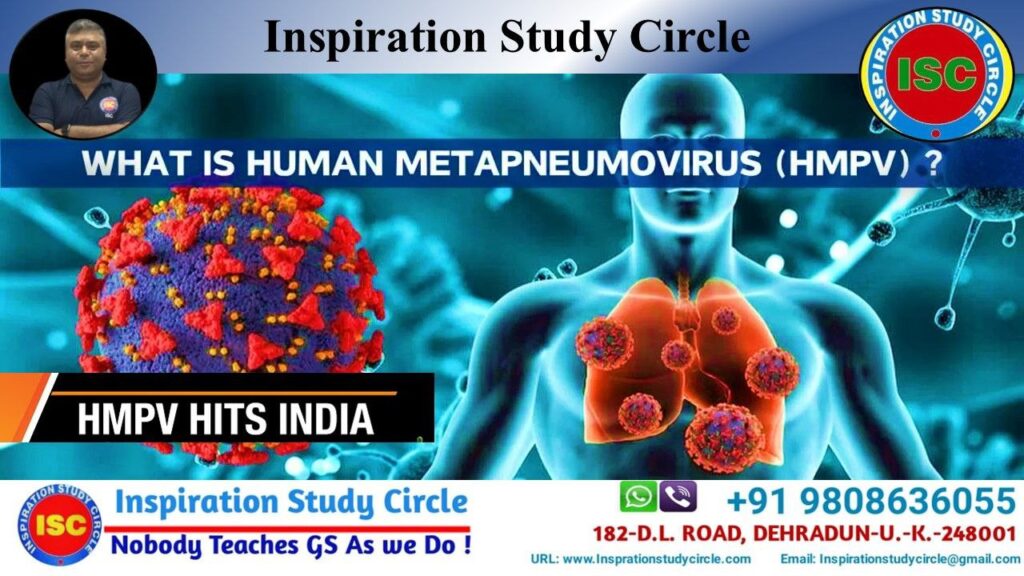
The Viksit Bharat – Guarantee for Rozgar and Ajeevika Mission (Gramin) Bill, 2025
The Viksit Bharat – Guarantee for Rozgar and Ajeevika Mission (Gramin) Bill, 2025 Table of Contents The Viksit Bharat – Guarantee

A common respiratory virus called human metapneumovirus, or HMPV has been spreading in some countries in Asia, including China, India, Malaysia, and Kazakhstan. Cases of a common respiratory virus called human metapneumovirus, or HMPV, are surging in several Asian countries, but experts say the situation shouldn’t trigger fears of a larger global health threat. HMPV falls into the same mix of winter bugs as influenza and respiratory syncytial virus (RSV), which often peak during this time of year in the Northern Hemisphere.
In mid-December 2024 health agencies in China reported an overall increase in respiratory infections, including an HMPV uptick in children under 14 years old in northern China. Reports of a hospital allegedly flooded with cases further fuelled the alarm and attention to this lesser-known yet common winter respiratory disease.
Human metapneumovirus (HMPV) is a negative-sense single-stranded RNA virus that belongs to the Metapneumovirus genus of the Pneumoviridae family.
HMPV was first identified in 2001 and is known to cause respiratory tract infections in people of all ages, particularly in young children, the elderly, and individuals with weakened immune systems.
Human metapneumovirus (HMPV) is a significant respiratory pathogen that causes respiratory tract infections in individuals of all ages, but particularly affects young children, the elderly, and those with weakened immune systems.
Understanding the causes, symptoms, and precautions associated with HMPV is crucial in managing and preventing its spread.
“The virus has circulated for at least 60 years, and genetic evolutionary studies suggest that it diverged from a bird virus between 200 to 400 years ago,” says John Williams, a pediatrician, and infectious diseases professor at the University of Wisconsin–Madison, who has studied HMPV for more than 20 years.
Causes of HMPV:
HMPV is a negative-sense single-stranded RNA virus belonging to the Metapneumovirus genus of the Pneumoviridae family. The virus was first identified in 2001 and has since been recognized as a common cause of respiratory infections worldwide. HMPV spreads primarily through respiratory droplets released when an infected person coughs or sneezes. Additionally, the virus can survive on surfaces and spread through contact with contaminated hands, which are then brought into contact with the face, facilitating transmission.
Symptoms of HMPV:
The symptoms of HMPV infection are similar to those of the common cold or flu. Individuals infected with HMPV may experience symptoms such as cough, fever, runny nose, sore throat, and difficulty breathing. In severe cases, HMPV infection can progress to more serious respiratory conditions like pneumonia or bronchiolitis, particularly in vulnerable populations. It’s essential to note that symptoms can vary in severity depending on the individual’s age and overall health status.
Precautions for HMPV:
In conclusion, understanding the causes, symptoms, and precautions associated with HMPV is essential in preventing the spread of this respiratory virus and minimizing its impact on public health. By following preventive measures such as handwashing, avoiding close contact with sick individuals, and staying home when unwell, individuals can reduce the transmission of HMPV and protect vulnerable populations from severe respiratory complications.
HMPV is recognized as a common cause of respiratory infections worldwide, with outbreaks occurring in both developed and developing countries. The virus spreads through respiratory droplets released when infected individuals cough or sneeze, making close contact a primary mode of transmission. Additionally, HMPV can survive on surfaces and spread through contact with contaminated hands, contributing to its global dissemination.
Factors Influencing Spread:
As of early January 2025, the situation regarding Human Metapneumovirus (HMPV) cases in India has garnered attention due to a recent increase in reported infections. Here’s an overview of the current status:
Rajasthan: 1 case involving a two-month-old infant currently being treated in Ahmedabad.
Health experts and officials have urged the public not to panic, emphasizing that HMPV is not a new virus and has been circulating globally since its identification in 2001. The virus typically causes mild infections, and most individuals recover without requiring extensive medical intervention.
The current situation of HMPV in India reflects a broader trend of respiratory infections typically seen during the winter months. While the number of cases has increased, health officials maintain that the virus does not pose a significant threat to public health, provided that appropriate precautions are taken.
We do not have a vaccine for HMPV yet. Health organizations and governments worldwide monitor the spread of respiratory viruses like HMPV to implement effective public health measures. Surveillance systems track the incidence and prevalence of HMPV infections to detect outbreaks early and facilitate timely interventions to control the spread of the virus.
In conclusion, the global spread of HMPV underscores the importance of international cooperation, robust surveillance systems, and public health interventions in combating respiratory infections and protecting populations worldwide. By implementing preventive measures and responding swiftly to outbreaks, countries can mitigate the impact of HMPV and other respiratory viruses on public health.

The Viksit Bharat – Guarantee for Rozgar and Ajeevika Mission (Gramin) Bill, 2025 Table of Contents The Viksit Bharat – Guarantee

How to Prepare for UKPCS 2026 in Six Months Table of Contents ISC- How to Prepare for UKPCS 2026 in

UKPSC Upper and Lower PCS Combined Batch for 2026-2027 Table of Contents Unlocking Uttarakhand’s Civil Services: The Power of UKPCS

Explained: Russian President Vladimir Putin’s State Visit to India Table of Contents Russian President Vladimir Putin conducted a state visit

UPPSC Upper PCS 2025: Mains Test Series and Answer Writing Table of Contents Inspiration Study Circle- Dehradun The UPPSC PCS

The Sanchar Saathi App Table of Contents The Sanchar Saathi app is a security and user-protection platform developed by India’s Department of Telecommunications (DoT) to help users manage mobile connections, report fraud, and locate lost phones